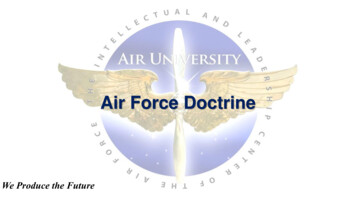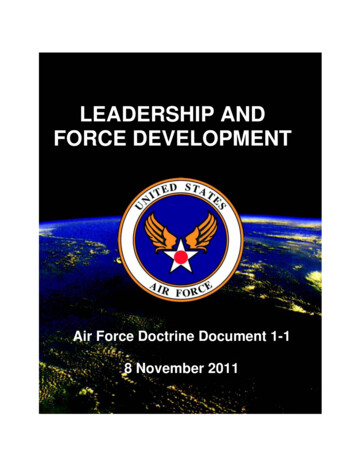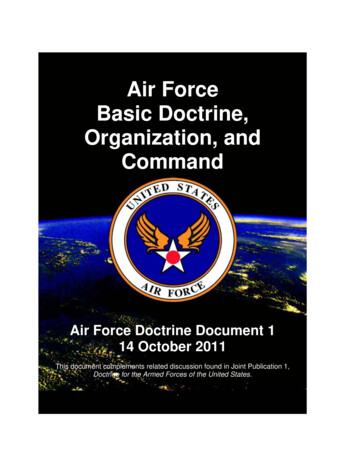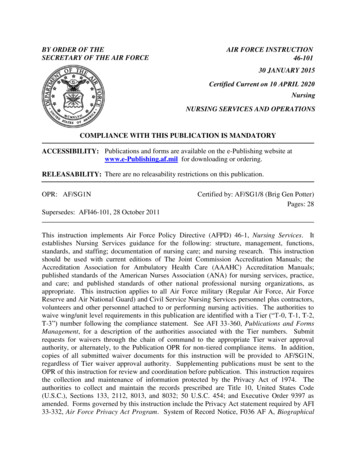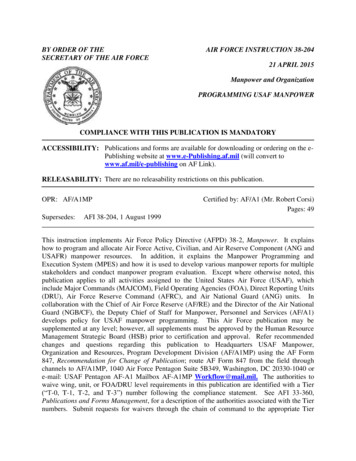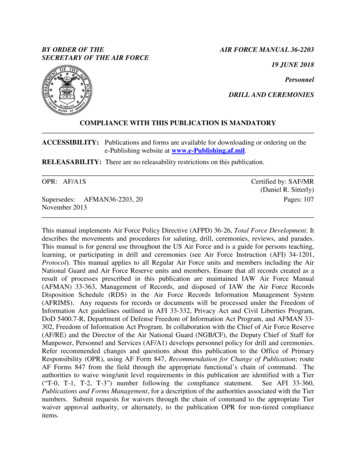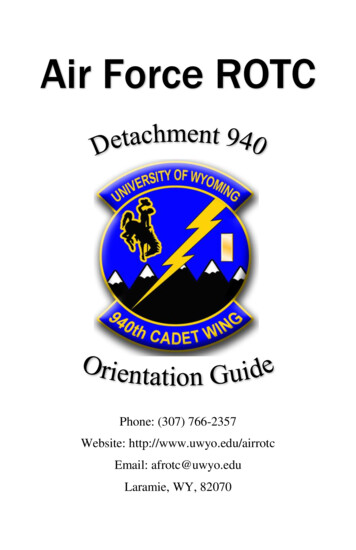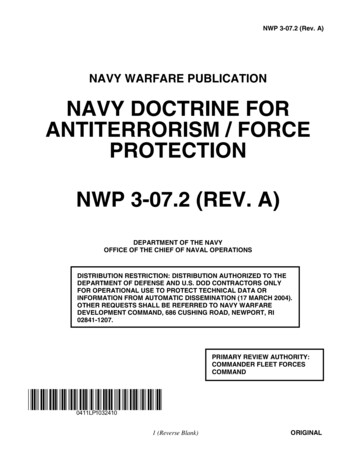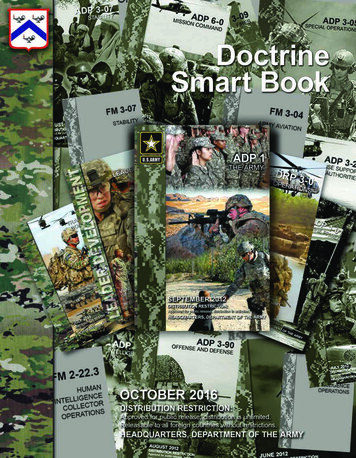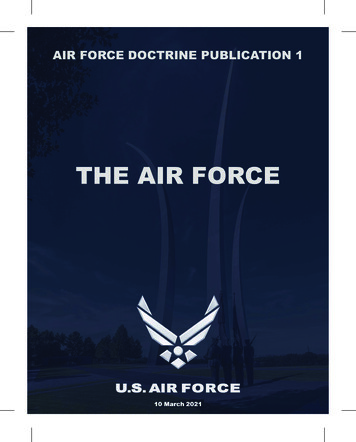
Transcription
Air Force Doctrine Publication 1, The Air ForceCSAF PERSPECTIVE ON DOCTRINEOur Nation needs an Air Force that can fly, fight, andwin as part of the joint team. Commanders mustarticulate intent and prepare to take the initiative indynamic, contested environments. Doctrine offers anagreed upon, operationally relevant body of bestpractices and principles that articulates how we fight,captures our airpower experience, and guides howwe operate within a joint force. It provides a startingpoint, so we don’t reinvent the wheel with everyoperation and allows us to continue to be the world’smost capable Air Force.In today's complex global security environment,victory goes to the rapid integrator of ideas. Theseideas are driven by training and the distilledknowledge all Airmen bring to the fight. I’m relyingon every Airman to innovate and incorporateconcepts and technologies that will develop newbest practices to shape future doctrine. We mustprioritize and make difficult choices as we field alethal, resilient, and rapidly adapting joint force.Leaders must push decisions to the lowestcompetent, capable level using doctrine as afoundation for sound choices.XX MONTH YEAR1
Air Force Doctrine Publication 1, The Air ForceDoctrine is an opportunity to educate, empower, andprepare for the future fight. It guides us, but does notbind us. I’m relying on every Airman to understandthe lessons of doctrine, and then draw on them toinnovate and incorporate concepts and technologiesthat will develop new best practices to shape futuredoctrine. This is how we solve difficult problems,make necessary changes, and how we acceleratechange in our Air Force.The tools in doctrine provide an excellentopportunity to build our foundation for future Airmenand forge unbeatable airpower for our Nation.Airmen should read, understand, contemplate, andprepare for the full spectrum of operations, fromcompetition to armed conflict. Never forget GeneralLeMay’s words: “At the very heart of warfare liesdoctrine.”CHARLES Q. BROWN, JR.General, USAFChief of Staff, United States Air Force2
Air Force Doctrine Publication 1, The Air ForcePREFACEAir Force doctrine is the extant and emerging bestpractices in the application of airpower. Doctrinedescribes the operations and activities that createconvergence of effects across the competitioncontinuum. Doctrine is organized as basic,operational, and tactical level doctrine. Basicdoctrine states the most fundamental and enduringbeliefs describing airpower and the Airman’sperspective. Operational doctrine describes moredetailed organization of forces and applies theprinciples of basic doctrine to military actions.Tactical doctrine is contained in Air Force and MultiService Tactics, Techniques, and Procedurespublications.Blue underlined text denotes a hyperlink to anothersource document, normally Air Force or jointoperational doctrine, for additional discussion.Air Force Doctrine Publication (AFDP) 1, The AirForce, forms the basis of our Service culture. Itdefines airpower, as the ability to project militarypower through control and exploitation in, fromand through the air. Airpower is employed toachieve joint force commander (JFC) objectives insupport of the National Defense Strategy (NDS).3
Air Force Doctrine Publication 1, The Air ForceAFDP 1 addresses four fundamental topics: Why We Fight - War: our foundational purpose asa Service.Who We Are - Airmen: our values.What We Do - Airpower: airpower fundamentalsand perspective.How We Do It - Tenets of Airpower: airpoweremployment considerations.Ideas presented here enable Airmen to describewhat the Air Force provides to joint all-domainoperations (JADO).4
Air Force Doctrine Publication 1, The Air ForceAir Force Doctrine Publication 1, TheAir ForceTable of ContentsChapter 1 – WHY WE FIGHT: WAR .6NATURE OF WAR .6LEVELS OF WARFARE .7AIRPOWER IN THE COMPETITION CONTINUUM .8NATIONAL DEFENSE STRATEGY & OBJECTIVES . 9Chapter 2 – WHO WE ARE: AIRMEN.13Chapter 3 – WHAT WE DO: AIRPOWER .16DESCRIPTION OF AIRPOWER . 16FOUNDATIONS OF AIRPOWER . 19AIRPOWER FROM AN AIRMAN’S PERSPECTIVE .21Chapter 4 – HOW WE DO IT: TENETS OF AIRPOWER. 26MISSION COMMAND . 28SYNERGISTIC EFFECTS.36PERSISTENCE . 36CONCENTRATION . 37PRIORITY .37BALANCE.38CONCLUSION . 395
Air Force Doctrine Publication 1, The Air ForceChapter 1 – WHY WE FIGHT: WARIn our victory over Japan, airpower was unquestionablydecisive. That the planned invasion of the JapaneseHome islands was unnecessary is clear evidence thatairpower has evolved into a force in war co-equal withland and sea power, decisive in its own right and worthyof the faith of its prophets.General Carl A. Spaatz, 1st Chief of Staff,United States Air ForceNATURE OF WARWar is one of the means used by nation-states, subnational groups, or supranational groups to achievetheir objectives. Conducting war from the airunderpins the reason for the Air Force’s existence.Airpower is an instrument of national power and canbe employed in warfare. There are three basic truthsthat the Air Force believes are fundamental towarfare: War is an extension of politics by other means.War has been described as a violent clash ofinterests characterized by the use of force. The AirForce conducts warfare as an extension of ournational policy.6
Air Force Doctrine Publication 1, The Air Force War is a complex and chaotic humanendeavor. Uncertainty and unpredictability,sometimes called the “fog of war”, combine tocreate what Clausewitz called “friction” whichmakes simple operations unexpectedly, andsometimes even insurmountably, difficult. Thetenets of airpower help Airmen apply airpowereffectively within this environment.War is a clash of opposing wills. War is acollision of two or more forces, producing adynamic interplay of action and reaction. The willof the people and the character of their leaders arecritical components of warfare.Sound doctrine, good leadership, effectiveorganization, moral values, and realistic trainingcan reduce the effects of uncertainty,unpredictability, and unreliability present in war.LEVELS OF WARFAREAirpower creates effects across all three levels ofwarfare: strategic, operational, and tactical. Thestrategic level of war defines why and with what theconflict occurs. The operational level of wardetermines what courses of action, in what order,and for what duration forces are employed in the7
Air Force Doctrine Publication 1, The Air Forceconflict. Finally, the tactical level of war defines howwe create the operational effects. Actions in waroccur at the tactical level, but an understanding ofthe operational and strategic implications of thoseactions is key to the employment of airpower inpursuit of our national objectives.AIRPOWER IN THE COMPETITIONCONTINUUMThe Air Force employs forces in pursuit of ournational objectives across the competitioncontinuum. Rather than the traditional binaryclassifications of peace and war, the competitioncontinuum describes a world of enduring competitionconducted through a mixture of cooperation,competition below armed conflict, and armedconflict. The Air Force creates effects across thecontinuum through the conduct of operations,military engagement, security cooperation,deterrence, and other activities.8
Air Force Doctrine Publication 1, The Air ForceFor detailed discussion on the competitioncontinuum, see Joint Doctrine Note 1-19,Competition Continuum, 3 June 2019.NATIONAL DEFENSE STRATEGY &OBJECTIVESThe National Defense Strategy sets the context inwhich Airmen must anticipate and plan across thecompetition continuum. Long-term strategiccompetition and the expansion of our adversary’smilitary capabilities threaten the United States’prosperity and security. Joint force operations are9
Air Force Doctrine Publication 1, The Air Forceincreasingly interconnected, interdependent, andchallenged. Our adversary’s anti-access and areadenial focus and proliferation of advancedtechnologies create contested environments thatreduce airpower’s ability to conduct globaloperations across the competition continuum,reduce freedom of maneuver, and challenge the AirForce’s ability to operate. This operatingenvironment requires examining how forces willsense, plan, decide, and act in concert across alldomains.The National Defense Strategy delivers theframework that defines the Department of the AirForce’s functions. The Air Force, as part of theDepartment of the Air Force, provides the Nationwith global vigilance, global reach, and global power.Service doctrine describes how to fulfill thatresponsibility. Global Vigilance is the ability to gain andmaintain awareness anywhere; to provide warningand to determine intent, opportunity, capability, orvulnerability; then to fuse this information with datareceived from other Services or agencies and useand share relevant information with the joint forcecommander (JFC).10
Air Force Doctrine Publication 1, The Air Force Global Reach is the ability to project militarycapability responsively–with unsurpassed velocityand precision–anywhere, and provide mobility torapidly supply, position, or reposition joint forces.Global Power is the ability to hold at risk or strikeany target anywhere, assert national sovereignty,safeguard joint freedom of action, and create swift,decisive, precise effects.The Air Force prepares and employs forces withinthis strategic environment to achieve our nationalobjectives. These objectives include defend thehomeland, remain the preeminent military power inthe world, ensure the balances of power remain inour favor, and advance an international order that ismost conducive to our security and prosperity. Whenthe Air Force mobilizes in the pursuit of theseobjectives, they are integrated as a part of the jointforce, led by a JFC.The Air Force organizes, trains, and equips forces tobe an air component to a JFC. As part of the jointforce’s air component, our forces must be preparedto accomplish JFC objectives. The air componentcommander’s administrative authorities are derivedfrom Title 10, U.S. Code and exercised as thecommander, Air Force forces (COMAFFOR). The air11
Air Force Doctrine Publication 1, The Air Forcecomponent commander’s operational authorities aredelegated from the JFC and exercised as both theCOMAFFOR, over Air Force Forces, and as thefunctional joint force air component commander(JFACC), over joint air forces made available fortasking. Thus, the air component commander leadsAir Force forces as the COMAFFOR and the JFC’sjoint air operations as the JFACC. This duality ofauthorities is expressed in the axiom: Airmen workfor Airmen and the senior Airman works for the JFC.12
Air Force Doctrine Publication 1, The Air ForceChapter 2 – WHO WE ARE: AIRMENOur Airmen are the competitive edge we have over ouradversaries and the reason we are the world’s greatestAir Force.JoAnne S. Bass, 19th Chief Master Sergeant of the Air ForceAll Airmen support and defend the Constitutionof the United States and live by Air Force corevalues. Historically, the term Airman is associatedwith uniformed members of the US Air Force (officeror enlisted; regular, Reserve, or Guard) regardlessof rank, component, or specialty.1 Today, Air Forcecivilians and members of the Civil Air Patrol, whenconducting missions as the official Air ForceAuxiliary, are incorporated within the broadermeaning of the term, Airman.Airmen espouse Air Force core values: Integrity first. Service before self. Excellence in all we do.This broader meaning does not, however, mean or imply that anyone other than uniformed members ofthe US Air Force are members of the Armed Services in other contexts. For example, in the context ofpunitive Air Force instructions or law of war regulations, care must be taken to ensure the rights andobligations imposed under those regulations are not uniformly applied to both Service members andcivilians.113
Air Force Doctrine Publication 1, The Air ForceSuccess hinges on the incorporation of these valuesinto the character of every Airman. Air Force corevalues are a commitment each Airman makes whenjoining the Air Force. They provide a foundation forleadership, decision-making, and success, no mattertheir rank, the difficulty of the assigned task, or thedangers presented by the mission.Every Airman is a leader and positively influencesothers to accomplish the mission. Leadership is theart and science of motivating, influencing, anddirecting Airmen to understand and accomplish JFCobjectives.2 Two fundamental elements of leadershipare the mission and the Airmen who accomplish it.Effective leadership transforms human potential intoeffective performance in the present and preparescapable leaders for the future. Airmen step forwardto lead others in accomplishing the mission whilesimultaneously serving as followers. You can be afine leader without a command, but you must be acommander without being a leader, or you may be agood leader to be an effective commander.32Air Force Manual 35-15, Air Force Leadership (1948): “Leadership is the art of influencing people toprogress with cooperation and enthusiasm toward the accomplishment of a mission.” Air Force Pamphlet35-49, Air Force Leadership (1985): “Leadership is the art of influencing and directing people toaccomplish the mission.” The definition in the text is a distillation of these earlier efforts.3Concept dates to AFM 35-15 pg 4 (1948).14
Air Force Doctrine Publication 1, The Air ForceI’m firmly convinced that leaders are not born; they’re educated, trained, andmade, as in every other profession. To ensure a strong, ready Air Force, wemust always remain dedicated to this process.General Curtis E. LeMay, 5th Chief of Staff, United States Air ForceAirmen understand the attributes of airpower andshould apply airpower with an appreciation for thebreadth, scope, and uniqueness it brings to joint alldomain operations. Airpower is fundamentallydistinct from other forms of military power. Itsinherent flexibility allows it to be appliedindependently or in concert with other forms ofmilitary power. Airmen have a distinct point of viewforged from air operations throughout history andour unique operating domains.15
Air Force Doctrine Publication 1, The Air ForceChapter 3 – WHAT WE DO: AIRPOWERRegardless of our respective ranks and positions, wemust execute to the best of our abilities and we must doit right the first time because the application of airpoweris serious business where half-hearted efforts andplaying for second place are not options.General Charles Q. Brown, Jr.,22d Chief of Staff, United States Air ForceDESCRIPTION OF AIRPOWERAirpower is defined as the ability to projectmilitary power through control and exploitationin, from and through the air. Elevation above theearth’s surface provides relative advantages andcreates a mindset that sees competition from abroad perspective. The air domain allows Airmen toexploit airpower’s attributes of speed, range,precision, tempo, lethality, and adaptability to createeffects in all domains. These attributes of airpowerchange the dynamics of competition in ways thatenhance the effectiveness of joint forces throughgreater mobility and responsiveness. Airmen havean appreciation for airpower’s broad potential.Airmen do not view or study airpower as an auxiliaryor complementary capability subordinate to anotherService. Airmen view their expertise in theapplication of airpower as the main reason for theService’s existence. The Air Force employs airpower16
Air Force Doctrine Publication 1, The Air Forceto achieve JFC objectives and to complement othercomponents of the joint force.The attributes of airpower create effects throughoutthe operational environment and competitioncontinuum. Airmen apply airpower by bypassinggeographical limitations or striking with precision atcritical vulnerabilities within adversary centers ofgravity (COGs) at long ranges, on short notice, andfor sustained periods. Airpower can control thetempo of operations in our favor and leaders employairpower in concert with all forms of military power.Airmen integrate capabilities across multipledomains to create effects in support of JFCobjectives through joint all-domain operations. Whileall Services rely heavily on such integration, joint alldomain integration is fundamental to how Airmenemploy airpower as part of the joint force.To enable convergence of effects in all domains,Airmen support JADO by conducting operationsprincipally in, from, and through: The air domain, defined as “the atmosphere,beginning at the Earth’s surface, extending to thealtitude where its effects upon operations becomenegligible.”17
Air Force Doctrine Publication 1, The Air Force The Information Environment (IE), which includesthe cyberspace domain. The IE is “the aggregateof individuals, organizations, and systems thatcollect, process, disseminate, or act oninformation,” while cyberspace consists of “theinterdependent networks of information technologyinfrastructures and resident data, including theInternet, telecommunications networks, computersystems, and embedded processors andcontrollers.” The effective use of information as aninstrument for affecting perceptions and behaviorsand to support human and automated decisionmaking is an increasingly important element ofjoint operations.The electromagnetic spectrum (EMS) is defined as“the entire range of electromagnetic radiation.” Itis critical for connecting the joint force and as amedium for creating effects, freedom of action inthe EMS at the time, place, and parameters of thejoint force’s choosing, is a required precursor tothe successful conduct of operations in alldomains.A comprehensive understanding of operations withinthe warfighting domains, the EMS, and IE are criticalto achieving JFC objectives.18
Air Force Doctrine Publication 1, The Air ForceThe other Services have air arms—magnificent airarms—but their air arms must fit within their Services,each with a fundamentally different focus. So those airarms, when in competition with the primary focus oftheir Services, will often end up on the short end,where the priorities for resources may lead to shortfallsor decisions that are suboptimum. It is thereforeimportant to understand that the core competencies of[airpower] are optional for the other Services. They canelect to play or not play in that arena. But if the nationis to remain capable and competent in air and space[sic], someone must pay attention across the wholespectrum; that is why there is a US Air Force.General Ronald R. Fogleman, 15th Chief of Staff,United States Air ForceFOUNDATIONS OF AIRPOWERThe evolution of airpower stems from the Airman’soriginal vision of combat from a distance, bypassingthe force-on-force clash of surface combat.Originally manifested in long-range aircraft deliveringkinetic weapons, airpower has evolved to includeother global capabilities, notably non-kinetic forcesand capabilities that can produce lethal or non-lethaleffects. Airpower evolution accelerated astechnological advancements allowed Airmen toconduct a greater percentage of operations globallyversus regionally.Airpower has successfully influenced strategicpolitical outcomes outside of armed conflict since the19
Air Force Doctrine Publication 1, The Air ForceBerlin Airlift of 1948. Throughout the Cold War, andcontinuing under various international arms controlagreements, Air Force assets have observed andverified compliance, leveraging our national ability tonegotiate and influence diplomacy.The Air Force provides JFCs options across thecompetition continuum, which may accomplishobjectives without the application of lethal force.Airpower has the ability to respond rapidly to crisesanywhere in the world with flexible options thatcontribute to global influence and stability, andcommunicate US capabilities and resolve toworldwide audiences. Examples include: The deterrent role played by the Air Force’snuclear-armed bombers and intercontinentalballistic missiles against the existential threatposed by adversaries’ strategic forces.The role mobility forces play in humanitarianassistance and disaster response worldwide.Aviation foreign internal defense by Air ForceSpecial Operations combat aviation advisors, tobuild partner capacity and help them protect theirsocieties from subversion, insurgency, orextremism.20
Air Force Doctrine Publication 1, The Air ForceAirmen apply the foundations of airpower across thecompetition continuum; translate the benefits ofairpower into meaningful objectives and desiredeffects; and influence the overall joint planning andexecution effort. As experts in the joint application ofairpower, the Airman’s perspective provides theability to force multiple dilemmas on adversaries,decreasing their decision space for potential coursesof action.AIRPOWER FROM AN AIRMAN’SPERSPECTIVEEffective airpower application requires an Airman’sunique perspective. Airmen gained this perspectivethrough a century of air operations experience.These distilled truths should be at the forefront of anAirman’s perspective when operating with jointpartners. Control of the air is a necessary preconditionfor control of the surface. The first mission of anair force is to defeat or neutralize the enemyairpower so friendly operations in all domains canproceed.21
Air Force Doctrine Publication 1, The Air Force Airpower creates effects at the strategic levelof warfare. Airpower, through global reach andglobal power, can hold an enemy’s strategicCOGs and critical vulnerabilities at riskimmediately and continuously through kinetic ornon-kinetic means. Airpower also has capabilityfor nonlethal strategic influence, as inhumanitarian relief and building partnershipactivities.Airpower exploits the principles of mass andmaneuver simultaneously. There are no naturalboundaries to prevent air capabilities from quicklyconcentrating (physically or in terms of deliveredeffects) at any point. Airpower can dominate thefourth dimension—time—and compress events toproduce physical and psychological shock.Airpower applies force against many facets ofenemy power. Global power enables airpower tobe brought to bear against any lawful target in anenemy system simultaneously or separately. Itenables rapid expression of our national willwherever and whenever necessary.Airpower is not bound by geographicaloperating areas and creates effects throughouta theater. Airmen view the application of force22
Air Force Doctrine Publication 1, The Air Forcemore from a functional than geographic standpointand classify targets by generated effects ratherthan physical location. Airpower’s attributes combine to make it oneof the most versatile components of militarypower. Its versatility allows it to be rapidlyemployed against strategic, operational, andtactical objectives and in support of multipletheaters simultaneously.The choice of appropriate capabilities is a keyaspect in the realization of airpower. Achievingthe full potential of airpower requires timely,actionable intelligence and sufficient commandand control (C2) capabilities to permitcommanders to exploit airpower attributes.Airpower is a critical component of operationsin the information environment. All Air Forceactions, including written or spoken words anddisplayed or related images, have informationalaspects that communicate some message orintent, which can be leveraged to support theachievement of JFC objectives. Shaping andleveraging those messages are integral tooperations and planning.23
Air Force Doctrine Publication 1, The Air Force Airpower provides more than lethal effects.Global vigilance enables airpower to alleviatecrises and provide a visible symbol of internationalsupport and power projection. Assisting partnernations, building alliances and the perception ofcredible airpower, supports deterrence andassurance activities that lead to greater regionalstability and security.Airpower requires protection and sustainmentto enable air operations and requires effectiveintegration of capabilities, people, weapons,bases, logistics, and supporting infrastructure.No single aspect of airpower should be treated inisolation since all elements are essential andinterdependent. The Air Force depends on Airmenwho command, operate, and sustain forces in anyenvironment including chemical, biological,radiological, and nuclear. The Air Force’s combatsupport capability and agile combat employmentprovide the ability to deploy globally, beginoperations, and sustain the initiative. Counterairand force protection capabilities provide defensefor forces. Airpower supports and is supported bymilitary power in other domains, from othercomponents, and from other Services.24
Air Force Doctrine Publication 1, The Air Force Airpower’s unique attributes necessitate it becentrally controlled by an Airman. Experiencehas shown the Air Force to be the preferred choiceof JFCs to exercise command and control (C2)over the joint air effort. Airmen tend to take abroad view of competition; their focus is onapplying airpower to accomplish the JFC’sobjectives. Airmen apply airpower through thetenet of mission command.25
Air Force Doctrine Publication 1, The Air ForceChapter 4 – HOW WE DO IT: TENETS OFAIRPOWERStrategic air assault is wasted if it is dissipated piecemeal insporadic attacks between which the enemy has anopportunity to readjust defenses or recuperate.Henry H. Arnold, General of the Air ForceThe application of airpower is refined by its tenets:Mission Command.Flexibility and versatility. Synergistic effects. Persistence. Concentration. Priority. Balance. These tenets reflect the unique aspects of airpowerand complement principles of joint operations. TheAir Force recognizes unity of effort as the 13thprinciple to highlight its importance.4 While theprinciples provide general guidance on theapplication of military force, the tenets providespecific considerations for the employment ofairpower.Joint doctrine recognizes Unity of Effort as a “common operating precept.” See Joint Publication 3-0,Joint Operations.426
Air Force Doctrine Publication 1, The Air ForcePrinciples of Joint Operations (JP 3-0)Unity of command – purpose is to ensure unity of effort under oneresponsible commander for every objective.Objective - purpose is to direct every military operation toward a clearlydefined, decisive, and achievable goal.Offensive – purpose of action is to seize, retain, and exploit theinitiative.Mass - purpose is to concentrate the effects of combat power at themost advantageous place and time to produce decisive results.Maneuver - purpose is to place the enemy in a position of disadvantagethrough the flexible application of combat power.Economy of force - purpose is to expend minimum essential combatpower on secondary efforts to allocate maximum combat power onprimary efforts.Security - purpose is to prevent the enemy from acquiring unexpectedadvantage.Surprise - purpose is to strike at a time or place or in a manner forwhich the enemy is not prepared.Simplicity - purpose is to increase the probability that plans andoperations will be executed as intended by preparing clear,uncomplicated plans, and concise orders.Restraint - purpose is to prevent the unnecessary use of force.Perseverance - purpose is to ensure the commitment necessary toachieve national objectives.Legitimacy - purpose is to maintain legal and moral authority in theconduct of operations.Unity of Effort (additional Air Force principle) - purpose is to ensurethat a wide range of agencies operating during a contingency coordinatetheir resources and focus on the same goal.27
Air Force Doctrine Publication 1, The Air ForceLike principles of joint operations, airpowertenets require informed judgment in application.Airmen tailor the application of tenets to theoperational environment. The competing demandsof the principles and tenets (for example massversus economy of force, concentration versusbalance, and priority versus objective) require anAirman’s nuanced understanding to strike therequired balance. Competition is interactivelycomplex, and no two operations are identical.Airmen apply professional judgment and experienceas they employ airpower.MISSION COMMANDThe Airman’s philosophy for the C2 of airpower ismission command. Mission command is anapproach to C2 that empowers subordinatedecision-making for flexibility, initiative, andresponsiveness in the accomplishment ofcommander’s intent. Mission command providesAirmen operating in environments of increasinguncertainty, complexity, and rapid change with thefreedom of action needed to exploit emergentopportunities and succeed. Given the global reachand strategic effects of airpower, the Air Force’sapproach to mission command balances the need28
Air Force Doctrine Publication 1, The Air Forcefor tactical flexibility with the management of globalrisks. Core principles of mission command are: Build teams through mutual trust. Built overtime through shared experiences, mutual trust isshared confidence between commanders,subordinates, and partners that they can be reliedon and are competent to carry out the mission.Create shared understanding. A common
Air Force Doctrine Publication 1, The Air Force 6 Chapter 1 - WHY WE FIGHT: WAR NATURE OF WAR War is one of the means used by nation-states, sub-national groups, or supranational groups to achieve their objectives. Conducting war from the air underpins the reason for the Air Force's existence. Airpower is an instrument of national power and can
